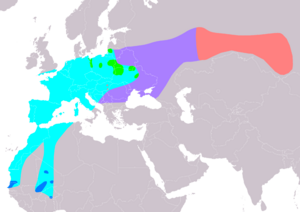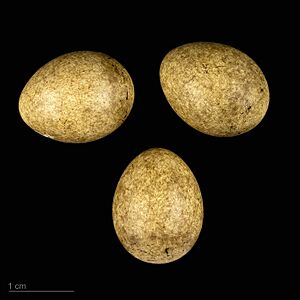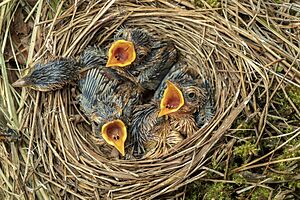Aquatic warbler facts for kids
Quick facts for kids Aquatic warbler |
|
|---|---|
 |
|
| Conservation status | |
| Scientific classification | |
| Genus: |
Acrocephalus (bird)
|
| Species: |
paludicola
|
 |
|
| Range of A. paludicola Breeding Passage Non-breeding Possibly Extant (passage) Probably extinct | |
The aquatic warbler (Acrocephalus paludicola) is a small bird that lives in Europe and Asia. It belongs to a group called "Old World warblers." This bird is quite special because it's the only songbird in mainland Europe that is globally threatened.
These birds are migratory. This means they travel very long distances. They spend their summers breeding in eastern Europe and western Asia. When winter comes, they fly all the way to west Africa. A big group of them, about 5,000 to 10,000 birds, spends winter in the Djoudj National Bird Sanctuary in Senegal.
Aquatic warblers prefer to live in wet areas with short grass and plants, usually less than 30 centimeters (12 inches) tall. Sadly, many of these wet areas have been drained. This has caused the number of aquatic warblers to drop. Most of the world's population, about 70%, now lives in the Polesie region of eastern Poland and southern Belarus.
Unlike many birds, aquatic warblers do not form pairs. Both males and females often have babies with different partners. They lay 3 to 5 eggs in a nest built low in the plants.
Contents
What Does an Aquatic Warbler Look Like?
The aquatic warbler is a medium-sized warbler. It has a brown back with lots of streaks, which are like thin lines. Its belly is pale, also with some streaks. Its head looks a bit flat on top, and its beak is strong and pointy. A clear whitish stripe runs above its eye, and another stripe is on its crown (the top of its head).
It can sometimes be mistaken for a young sedge warbler. However, the aquatic warbler's head stripes are much clearer. It also looks paler and has a spiky tail when it flies. Male and female aquatic warblers look the same. Young birds have no streaks on their chest. Like most warblers, they mainly eat insects. But they also enjoy other small foods, like berries.
The song of an aquatic warbler is a fast, chattering sound, like "ja-ja-ja." It also includes special whistling sounds.
The name Acrocephalus comes from ancient Greek words meaning "highest" and "head." The word paludicola is Latin, meaning "swamp dweller."
Protecting the Aquatic Warbler
The aquatic warbler is the rarest and only internationally threatened songbird in mainland Europe. Almost all of its breeding areas are in Europe.
Why Are Aquatic Warblers in Danger?
The biggest problem for these birds is the loss or damage of their homes. This happens when wetlands are drained. Also, old farming methods that helped keep their habitat open are not used as much anymore. This allows reeds, bushes, and trees to grow too tall, covering the short plants the warblers need.
To help protect them, many countries have signed an agreement called the Aquatic Warbler Memorandum of Understanding. This agreement started in 2003. It brings together governments, groups, and scientists from 22 countries. They all work together to save the aquatic warbler and its habitat. A lot of money for protecting their homes comes from the EU's LIFE programme.
How Are We Helping Them?
One main way to save the aquatic warbler is to bring back their natural homes. This means cutting down bushes, reeds, and trees that have grown too much. They also install special equipment to control water levels, making sure the wetlands stay wet enough.
Farmers also play a big role. To protect the baby birds, farmers are asked to cut their grass later in the season, usually after August 15. They also use special mowing machines that are safer for the birds. Since this late-cut grass isn't good for feeding animals, farmers get money from the government to help them. The grass that is cut late can then be turned into biofuel or grass pellets.
Moving Birds to New Homes
Sometimes, there are very few aquatic warblers left in certain areas. Their groups can become too small and separated. To help them, scientists have started moving young birds to new places. This helps to increase the number of birds and improve their genetic diversity.
For example, in June 2018, a group called the Lithuanian Baltic Environmental Forum (BEF) successfully moved 49 aquatic warbler chicks. They brought them from Zvanec, Belarus, to the Žuvintas biosphere reserve in Lithuania. The chicks were raised and then set free. By the next summer, 11 of these moved birds (22%) returned to the Žuvintas reserve to breed.
In the summer of 2019, the BEF moved another 50 birds from Belarus to the Žuvintas reserve. This project helps to make the warbler populations stronger in Lithuania.
Where Do Aquatic Warblers Live?
Aquatic warblers live in different parts of Europe and Asia. Their total population is about 11,000 to 15,000 pairs.
- Central Europe: This is where most aquatic warblers live, with about 10,769 singing males. However, their numbers here are generally going down or changing a lot.
* Belarus has about 4,120 birds, but their numbers are decreasing. * Ukraine has about 3,653 birds, but it's hard to know the exact trend. * Eastern Poland is a positive spot, with about 2,996 birds, and their numbers are actually increasing!
- Lithuania: This country has about 110 birds. Their numbers dropped a lot until 2013, but they have been increasing since then, partly thanks to the bird moving projects.
- Hungary: Sadly, no aquatic warblers have been seen breeding here since 2011.
- Western Poland and Germany: These areas have very few birds left, and their numbers have been dropping for a long time.
- Siberia (Russia): There might be a small group of birds here, but it's not clear how many, and they might even be gone now.
Overall, the global population of aquatic warblers is staying somewhat stable. However, many smaller groups in different areas are still shrinking. This shows how important it is to keep working hard to protect them.





